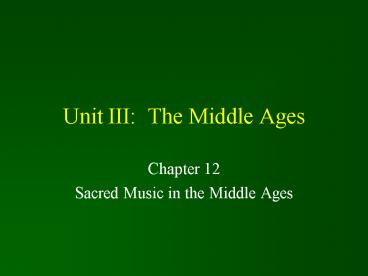Unit III: The Middle Ages - PowerPoint PPT Presentation
1 / 16
Title:
Unit III: The Middle Ages
Description:
Gregorian chant (plainchant or plainsong) owes ... Characteristics of Chant. monophonic ... Notre Dame School Organum: Gaude Maria virgo (Rejoice Mary,virgin) ... – PowerPoint PPT presentation
Number of Views:607
Avg rating:3.0/5.0
Title: Unit III: The Middle Ages
1
Unit III The Middle Ages
- Chapter 12
- Sacred Music in the Middle Ages
2
Chant
- Gregorian chant (plainchant or plainsong) owes
its roots to the single-line melodies of Greek
and Hebrew music - Named after Pope Gregory the Great (reigned
590-604) - While there is some controversy over the subject,
chant is largely agreed to be nonmetric
3
Characteristics of Chant
- monophonic
- free-flowing vocal line which reflects the
inflections of the Latin text - generally agreed to be nonmetric
- largely conjunct melodic motion
- approximates a sort of musical speech
4
Notation of Chant
- For many generations, chant was handed down
purely by oral tradition. As the number of
chants vastly increased, the need for some sort
of written reminder became clear - The first notational devices used were neumes
which served as the reminder of the contour of
the melody. Staff lines were added later
5
Example of a Fully Notated Gregorian Chant
6
Text Setting
- syllabic - one note sung to each syllable of text
- neumatic - groups of 2 to 4 notes sung to each
syllable - melismatic - long groups of notes sung over
single syllables (Eastern origin)
7
Modes
- Modal scales, including the precursors to modern
major and minor scales were the primary musical
materials of chant - With polyphony, harmonic systems evolved based on
these scale patterns - The term modal usually refers to the use of these
ancient scales while tonal refers to the use of
major or minor scales
8
The Mass
- The term refers to the collection of prayers and
readings which make up the primary service of the
Catholic church - The texts fall into two main categories
- Proper Those texts which change from day to day
dependent on the time of year, the feast being
celebrated or the saint being honored - Ordinary Those texts that do not change from
service to service
9
(No Transcript)
10
Hildegard of Bingen Alleluia, o virga mediatrix
(Alleluia, O mediating branch)
- A Gregorian Chant for feasts of the Virgin Mary
- fifth item from the proper of the mass
- Sung in praise of the Virgin Mary
- Melismatic, then neumatic
- responsorial
- verses sung by soloist
- response sung by choir
- Monophonic
- See Listening Guide 2, p.73, (CD 1/1-3)
11
The Rise of Polyphony
- A major breakthrough occurred at the end of the
Romanesque period (c. 850-1150) with the
emergence of polyphony - At first chant melodies were decorated by
ornamented versions of themselves (heterophony) - Eventually the chants evolved into a polyphonic
structure in which two independent voices created
a polyphonic structure based on the chant itself.
This is known as organum
12
Organum
- Organum came about by the addition of a second
voice which parallels the original chant melody
at the interval of a 4th higher or 5th lower
13
Notre Dame School
- During the twelfth and thirteenth centuries the
center of composers of organum was the Cathedral
of Notre Dame in Paris. The composer whose name
is earliest associated with this music is Léonin - with the earliest composed organum, the Gregorian
melody was sung by the lower voice - the upper voice was a newly-composed, rapid
melody employing fixed patterns of long and short
note values, known as rhythmic modes
14
The Early Medieval Motet
- Pérotin extended Notre Dame organum to include 3
or even 4 voices - The addition of texts to these upper voices late
in his career resulted in the motet, the root of
which means word in French - At this time the text could be either all Latin
or combinations of Latin and French, secular and
sacred texts
15
Notre Dame School Organum Gaude Maria virgo
(Rejoice Mary,virgin)
- See Listening Guide 3, p.75. CD1/4-5
- an anonymous three-voice organum from the
thirteenth century in the style of Pérotin - the bottom voice, the tenor (from the Latin
tenere to hold) sounds the original chant notes
of Gaude Maria - instrumental or vocal
- rhythmic ostinato (long-long-short-long)
16
Hildegard von Bingen (1098-1179)
- founded her own convent
- renowned prophet, composer, and healer
- music resembles Gregorian chant, but unlike most
music of her day did not draw on existing
repertory - best known work is the earliest example of a
morality play, The Play of Virtues (Ordo virtutum)































